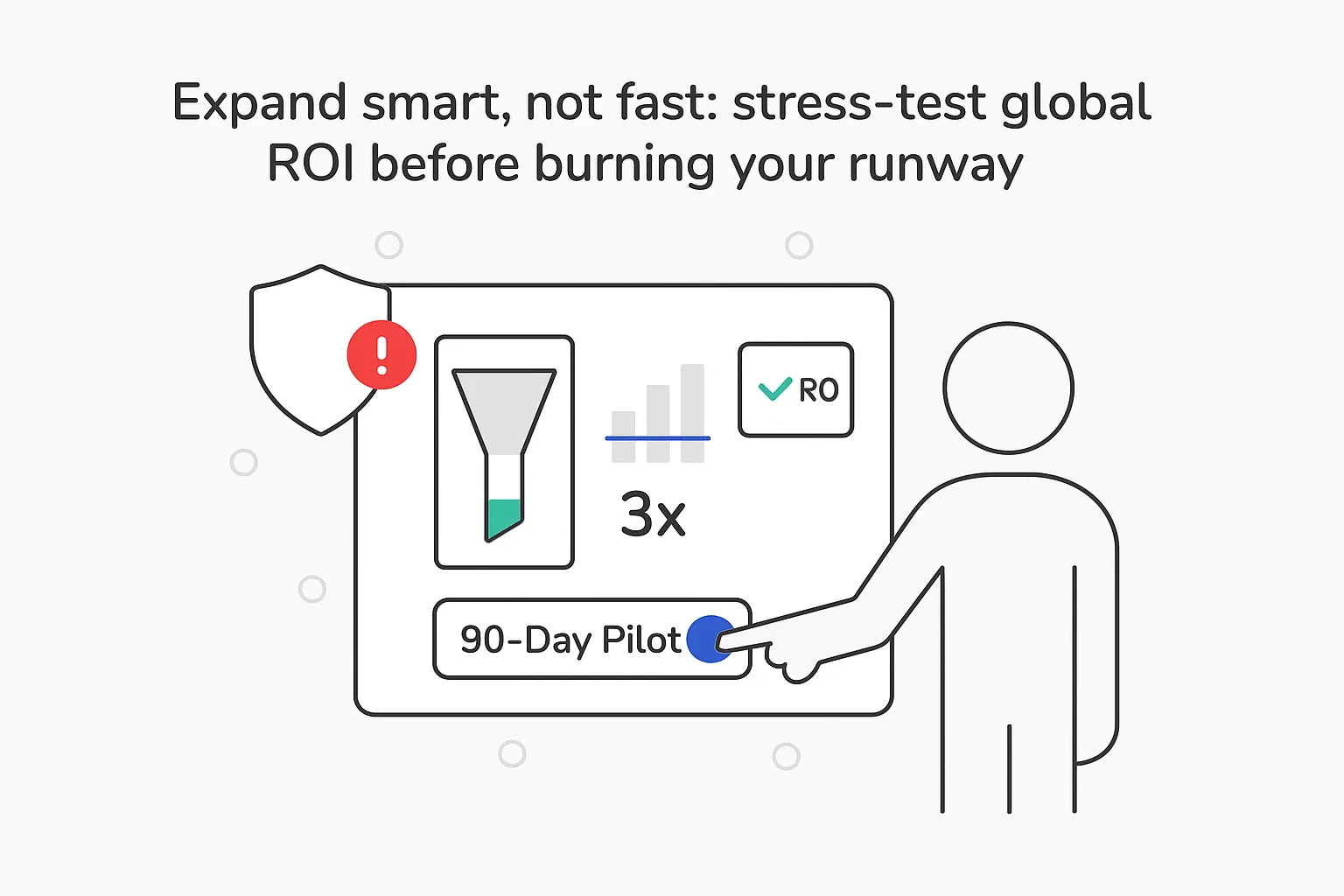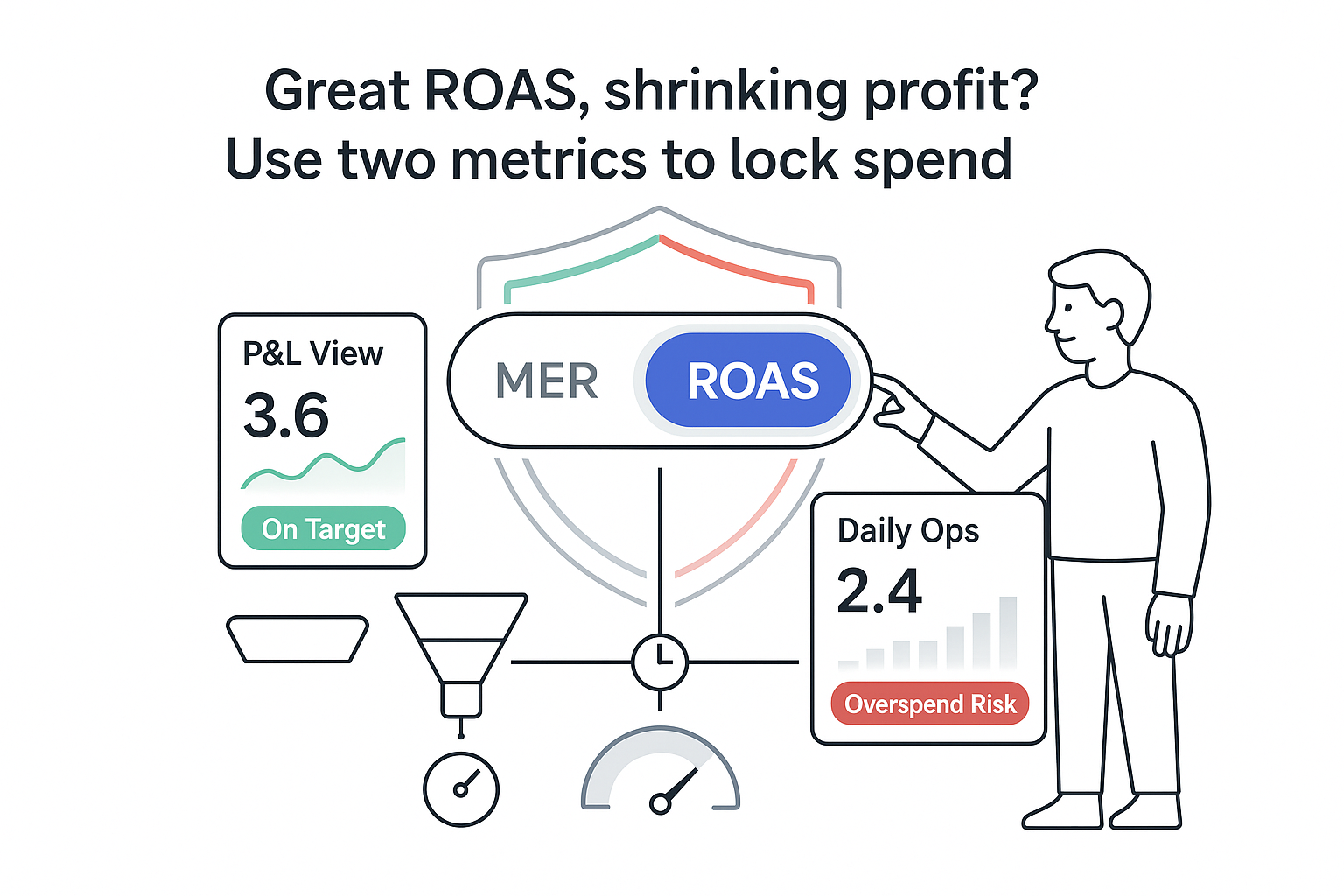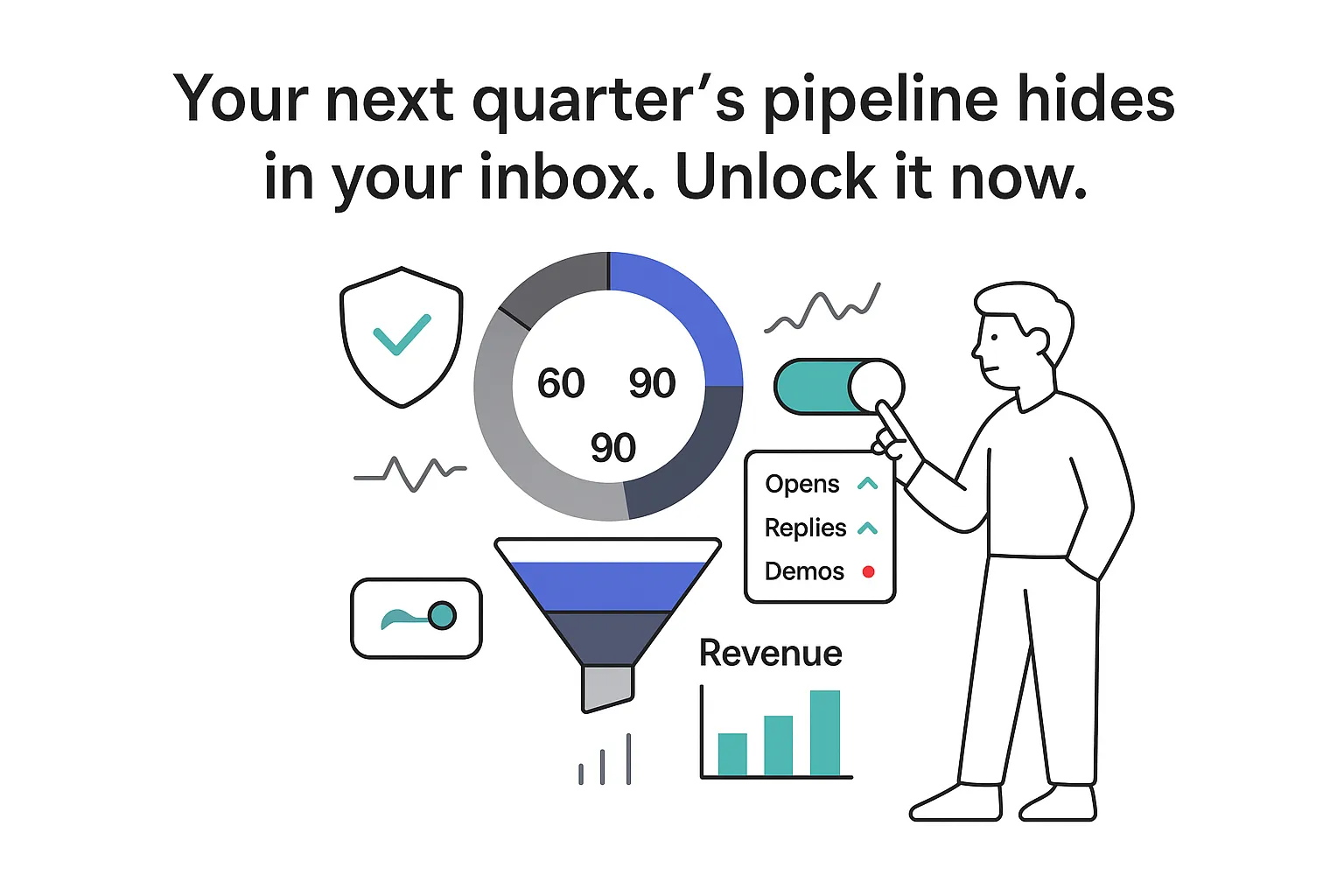I want growth without chaos. Selling to new countries can do that, but only if the math, the model, and the team are ready. I think in stages: first, prove demand. Then, confirm I can deliver. Finally, scale what works. I wrote this for B2B service leaders who want a steady pipeline, clear ROI, and no hand-holding.
Key questions before selling internationally
If I’m weighing an international move, I follow a clear decision path. I don’t need a grand plan. I need proof points. This order keeps risk low and confidence high.
- I choose 1 to 2 target countries based on demand signals, not hunches (inbound requests, qualified traffic/search volume, partner pull, or active RFPs).
- I validate a minimum viable pipeline and payback math (details below).
- I confirm compliance, contracting, and invoicing rules for those countries.
- I localize only what moves deals - case studies, first-touch language, SLAs, and pricing currency - rather than everything at once.
- I price for margin after tax and currency costs.
- I decide my go-to-market mode (direct or partners), then run a 90-day pilot.
Go or No-Go for B2B services
- I go if I can create 3× pipeline coverage in 60 days and my CAC payback is under 12 months (calibrated to my baseline).
- I go if I can deliver the service with on-time SLAs in local business hours without burning out the team.
- I go if data privacy, contracting, and tax rules are documented with a named owner and the needed tooling is in place.
- I don’t go if my win rate drops by half once deals cross borders and I cannot explain why.
- I don’t go if I need heavy custom work to win the first five deals.
- I don’t go if currency swings erase my margin and I lack hedging or buffers.
I treat these as thresholds, not absolutes. If my normal sales cycle or win rate differs by industry, I adjust the bar rather than forcing a rigid rule.
Should I sell internationally? ROI first
I start with ROI, not ambition. Within 12 months, revenue from new international deals should cover customer acquisition cost (CAC) and delivery costs, with margin left over.
Quick payback math
- ACV means annual contract value; gross margin is ACV minus direct delivery costs.
- Payback months = CAC divided by (ACV × gross margin percentage ÷ 12).
- Example: If ACV is 60,000 and gross margin is 60%, gross profit per year is 36,000 (3,000 per month). With a CAC of 30,000, payback is 10 months. In practice, I plan for a buffer.
Minimum viable pipeline
- Needed pipeline per quarter = target new ARR ÷ expected win rate.
- Example: If I plan to add 300,000 ARR at a 25% win rate, I need 1.2 million in qualified pipeline. For early pilots, I target 3 to 4× coverage to absorb surprises.
Fast self-assessment scorecard (0 to 2 points each)
- Demand: Do I see at least ~500 monthly searches for core service terms plus active RFPs or third-party intent signals in the target country.
- Fit: Do I have at least two case studies that match the new market’s industry, company size, and stack.
- Delivery: Can I cover local hours and language for kickoff and support without heroic efforts.
- Finance and legal: Can I invoice locally, handle tax, and sign compliant contracts.
- Sales cycle: Can I keep the cycle within 120 days or within 20% of my home-market baseline.
Score 7 to 10 = green light for a pilot. Score 4 to 6 = fix blockers first. Below 4 = not now.
Common pitfalls I watch
- Time zones create hidden costs in handoffs and meetings; I use a follow-the-sun rota and asynchronous updates to reduce friction.
- Delivery models strain when I promise local hours but don’t staff for them; I define response windows honestly.
- Approvals take longer due to procurement norms and data reviews; I timebox security/legal steps and pre-stage standard documents.
- Currency and tax nibble margin if I copy/paste home-market pricing; I account for FX buffers and reverse-charge rules up front.
International market research
I match my offer to demand, then check how buyers actually buy. I blend keyword data, firmographics, and procurement signals. The goal is simple but structured.
What I size and scan
- TAM by region: company counts by industry and employee band (national registries, market datasets, and professional networks).
- Intent and search: non-brand search demand, seasonality, and cost-per-click ranges to sanity-check inbound potential.
- Competitor density: SERPs, sponsored ads, case study pages, and partner directories to see who is active and how they position.
- Procurement norms: whether three quotes, framework agreements, or local presence are required; I read government and enterprise vendor pages.
- Buying committee: which roles drive evaluation, security, and signoff; I map objections early.
A 5-step desk research workflow
- Keywords: I list core service terms plus country modifiers and gather monthly volumes, CPC, and SERP features.
- SERP review: I note page-one patterns - comparison pages, thought leadership, certifications, or partner listings.
- Pricing scans: I read public pricing and proposal hints to capture billable rates, minimums, and included hours.
- Review sites: I look at adjacent software signals and service references in the target country to infer maturity and expectations.
- Firmographics: I build a 500 to 1,000 account list filtered by headcount, tech stack signals, and hiring trends.
Prioritization tip
I create a shortlist of 2 to 3 countries where demand, competition, and procurement rules form a clear path. The perfect market does not exist. I want a country where my current strengths win fast.
International compliance
Services face fewer border checks than goods, yet the risks are real. I think data, tax, contracts, and sanctions - and I assign owners early so nothing slips. This is information, not legal advice; I confirm details with counsel.
Data privacy
- EU and EEA: GDPR and ePrivacy apply. Standard Contractual Clauses for transfers; I consider EU hosting if processing sensitive data.
- UK: UK GDPR and DPA; I use the UK addendum to SCCs for transfers.
- Canada: PIPEDA and provincial laws; I clarify storage location in contracts.
- Australia: Privacy Act; reforms may tighten breach reporting.
- U.S. buyers: Expect SOC 2/ISO 27001 evidence and state privacy rules (e.g., CCPA). Cross-border transfers should be documented.
Contracts and invoicing
- Cross-border contracting: I pick governing law and venue my counsel can support and include data processing and security exhibits.
- VAT and GST on services: In the EU, B2B services often use reverse charge (invoice without VAT and include the buyer VAT ID). The UK has similar rules for many services.
- Canada GST/HST and Australia GST: Non-resident suppliers may need to register; I check place-of-supply rules.
- E-invoicing: Some countries use Peppol or local rails; my AR tooling should support them if needed.
Sanctions and export controls
- I screen new clients against OFAC, EU, UK, and UN lists.
- If I deliver technical services, I review U.S. EAR/ITAR exposure; remote access to controlled tech can count.
Ownership and operating rhythm
- Data: CISO or Head of Security (policy, transfer, and audit readiness).
- Tax and invoicing: Controller or Head of Finance (registration, reverse charge, e-invoicing).
- Contracts: General Counsel or outside counsel with cross-border experience.
- Sanctions and screening: Finance or Legal (documented screening workflow).
I keep a one-page compliance matrix by region and review it quarterly.
Product localization
I don’t rebuild the service; I make it feel local where it matters. I change the wrapper first, then the workflow.
Packaging
- I name the package in the buyer’s language but keep structure consistent.
- I adjust SLAs to local business hours; if I can’t cover full days, I state response windows clearly.
- I add a delivery model graphic that shows who does what, where, and when.
Proof
- Case studies by locale, with outcomes in local currency and metrics that resonate in that region.
- References who can speak the language or at least operate in that time zone.
- Certifications that carry local weight (e.g., ISO 27001, Cyber Essentials in the UK, or IRAP for Australian government work).
Language and support
Country pages with hreflang tags; I translate navigation and headings first, then the top 20% of copy that sells. Live chat or intake forms should accept multiple languages so the first touch feels easy. For more on multilingual support, see Seamless Support: AI Translation's Role in Customer Experience.
International SEO basics inside localization
- Country-specific pages (e.g., /uk, /de) with localized copy and pricing hints.
- Hreflang tags across variants, including x-default for the global page.
- Local backlinks from associations, chambers, and partner pages.
- Structured data for organization and service schemas with localized contact info.
Internal delivery tweaks
- I adjust templates, reporting cadence, and holidays; a simple local holiday calendar prevents missed deadlines.
- I create a glossary so translators and consultants use the same terms every time.
For a practitioner’s perspective on localization and support, explore author insights from Mary Shacklett.
International pricing
Price is not just a number - it’s margin, risk, and expectation in one line. I set a home-base price, then localize with clear rules.
Strategy for services
- Market-based price: I validate willingness to pay by industry and company size and anchor value to outcomes, not hours.
- Currency options: I quote in buyer currency to reduce friction and support USD for cross-border stability where accepted.
- FX buffers: I add 3% to 5% buffers or price bands reviewed quarterly and hedge if volume justifies it.
- Billing cadence: Quarterly or annual terms shorten payback; I offer monthly only with setup fees or a higher list price.
- Regional discount norms: Some countries expect 10% to 15% negotiated discounts; I bake this into the list.
Taxes on services
- EU/UK B2B: Usually reverse charge; I show the buyer VAT ID and the reverse-charge note.
- Canada/Australia: I confirm GST/HST duties based on registration status and place-of-supply rules.
Simple price localization snapshot (relative to home base)
- US: 100% list, USD, 0% to 2% buffer, typical discount 0% to 10%.
- UK: ~105% list, GBP, ~3% buffer, typical discount 5% to 12%.
- EU: ~110% list, EUR, 3% to 5% buffer, typical discount 5% to 15%.
- AUS: ~110% list, AUD, ~5% buffer, typical discount 5% to 12%.
- CAN: ~105% list, CAD, ~3% buffer, typical discount 5% to 10%.
I review every quarter. If FX swings beyond my buffer, I update new quotes, use quote-validity windows, and protect margin.
Sales partners
Direct can be faster to learn; partners can be faster to scale. The right answer often mixes both. I start with clarity on model, margin, and enablement.
Partner models for services
- Referral partners: They introduce prospects; I sell and deliver; they earn 5% to 15% for a set period.
- Resellers: They sell my service, sometimes co-deliver; they earn 15% to 30% and need sales rights and SLAs.
- Implementation partners: They deliver part of the work; margins vary by scope; I standardize methodology and QA.
- Distributors of services: Rare, but useful for regulated or public-sector access; margins are higher, expectations stricter.
Enablement needs
- A short country playbook with ICP, discovery questions, and objection handling.
- Co-branded case studies and a pricing one-pager with rules of engagement.
- Deal registration, a shared forecast, and a named partner manager.
Due diligence checklist
- Fit: Do they already sell to my ICP in that country.
- Proof: Can they show two recent deals of similar size and complexity.
- Capacity: Named sellers and consultants assigned, not just promises.
- Compliance: Basic security and contracting maturity.
- References: Two client references from the last 12 months.
Where I find partners
- Targeted searches by country, service, and certifications.
- Trade associations and chamber directories.
- Cloud marketplaces and app partner programs listing service partners.
- Conferences with local tracks; I follow up with speakers and sponsors.
Margin expectations
I start low-risk and pay higher margins as partners bring repeatable pipeline and quality delivery. I tie tier upgrades to quarterly revenue and CSAT, not just signups.
International capacity: a 90-day pilot
Capacity is where plans meet reality. I aim for a 90-day pilot that proves repeatability. I staff light, measure hard, and document as I go.
Staffing coverage
- I follow the sun with a simple rota; I cover discovery and kickoff in local hours. Deep work can stay in my home time zone if SLAs allow.
- Language skills: at least one salesperson or consultant who can run meetings in the buyer language, even if documents stay in English.
Onboarding and playbooks
- A compact country playbook with pricing rules, contracting notes, and delivery templates.
- CS and billing tooling that supports multiple currencies, time zones, and tax-compliant invoicing.
Legal and finance ops
- Ready-to-sign terms with local law flavors and correct tax notes on invoices.
- A collections process that reflects bank transfer norms and payment terms.
Support and SLOs
- I define response and resolution times that I can keep; I publish and track them.
- I add a queue tag by country to see volume and speed by region.
My 90-day pilot plan
- Weeks 1 to 2: Launch country pages and one outbound sequence. Localize two case studies. Align pricing and invoicing in my CRM and billing system.
- Weeks 3 to 6: Run outbound and paid search tests with small budgets. Attend two local events or webinars. Log discovery calls by region.
- Weeks 7 to 10: Push three deals to proposal. Run security and legal reviews to timebox friction. Tune SLAs and staffing if response times slip.
- Weeks 11 to 13: Close one to two deals, start delivery, and capture reference quotes.
Pilot KPIs
- Top of funnel: 20 to 30 meetings booked from target accounts.
- Mid funnel: 6 to 10 sales-qualified opportunities.
- Pipeline: 3× target ARR coverage.
- Close rate: 20% to 30% on SQOs.
- Delivery: 95% of SLAs met in local hours.
- Satisfaction: first two clients score 8/10 or higher on a kickoff survey.
Governance
I create a simple RACI so decisions move fast.
- Executive sponsor: funding, go/no-go calls.
- Country lead: pipeline, pricing, partners.
- Delivery lead: staffing, SLAs, quality.
- Legal and finance: contracts, tax, invoicing.
- Marketing: country pages, campaigns, case studies.
A brief reality check
Speed feels exciting. Caution keeps me safe. The trick is to run small, well-measured tests that show what the big rollout should look like. Selling internationally rewards teams that make clear promises, keep them, and learn quickly. If I pick my first two countries with care, make the numbers work, and keep the service tight, the rest starts to feel almost easy - almost - and that’s the right kind of tension.







.svg)